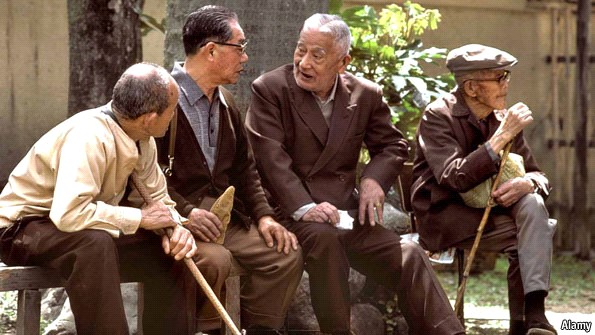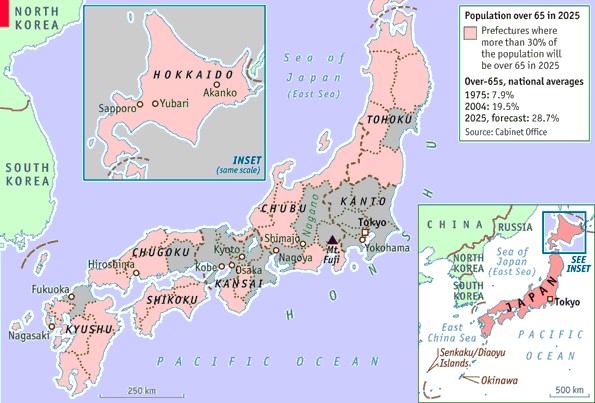

 字體:小 中 大
字體:小 中 大 |
|
|
|
| 2018/03/05 14:48:28瀏覽23|回應0|推薦0 | |
Demographics and GDPGraysiaSep 28th 2011, 13:54 by The Economist online The economic impact of demographics in Asia INVESTORS are often lured to countries like India and Vietnam by their demographic promise—by their fast-growing population of workers and consumers. Likewise, investors in China often worry that it “will grow old before it grows rich”. Demographics are not destiny, but they are a noteworthy determinant of economic potential. Youngsters and retirees do not work, which harms growth directly. And because these dependants make a claim on a country’s income without adding to it, they also depress savings, thereby slowing the accumulation of capital and the growth of productivity. In its latest Asian Development Outlook, the Asian Development Bank calculates the contribution of Asia’s youthful demographics to its economic success over the past decade. The bank also projects the impact of a greying population on Asia’s growth from now until 2030. · Recommended · 39 · inShare6
Graysia Sep 29th 2011, 00:29
In general, the aged society often accompany the limit of the economic growth. The aging trend may result in the decline of economic, easily becoming the cause of turmoil especially if the GDP is not large enough to reach certain threshold. For example, Taiwan’s GDP is not very high enough to practise too many pension plans, but Taipei’s ruling Kuomintang insists on the so-called welfare policy too changeably and unreasonably such as recently noisy case of “old-farmer pension” only to lead Taiwan’s economy to be weaker. In comparison with Taiwan, Japan’s Democratic Party of Japan gradually work on the moderate project of pension, which seems to be about to succeed in near future not only due to the clear blueprint but also the fund from the government long-term accumulation of fair tax. In addition to the better plan, the rational allocation of pension to the aged through precise formula can benefit people or even make new style of sub-economic circle such as “aged economy”, which would reslove the possible hardship. So any officer in government who earlier finds out the way of new source in financial development can keep growing the country continuously.
Recommended 4 Report Permalink 這篇是經濟學人雜誌每兩週至一月的專題報導欄的其中一篇的回應。正文是探討高齡化亞洲社會。筆者順便提到從阿扁總統的每月四千元老農津貼,連續幾月以來成為當年台灣朝野攻防的主戰場,老農際遇成為悲歌。另一方面,在日本高齡化社會及高齡退休所扮隨的長青經濟學,筆者在稍逛過相關日本電商及報紙評論後,歸訥到有其願景及作為協助社會福利政策的途徑。當時仍是民主黨執政,願以赤字預算編列但造成國債負擔,若有產業的推動協力,會減輕不少也能夠有效率及快速呼應市場的平行完成社會福利工作。 附2010年11月18日的A Special Report on Japan的概論文章,該特報主要探討在DPJ在2009年取代LDP執政後,怎樣面對日本人口老化問題。 A special report on Japan Into the unknown Japan is ageing faster than any country in history, with vast consequences for its economy and society. So why, asks Henry Tricks, is it doing so little to adapt? Nov 18th 2010
FOR a glimpse of Japan’s future, a good place to visit is Yubari, a former mining town on the northern island of Hokkaido, which four years ago went spectacularly bust with debts of ¥36 billion ($315m). It is a quiet spot, nestled in a valley at the end of a railway line. When the coal mines were working 40 years ago, 120,000 people lived there. But the mines have long since closed, and now there are only 11,000 people left, almost half of them over 65. The town hall is like a morgue, with few lights on. In the past four years the number of civil servants has been cut in half, their salaries have shrunk by a third and they now have to mop their own floors, they complain. The town has embarked on an 18-year austerity drive to repay its debts. The public library has already closed down. This autumn six primary schools merged into one. Even so the townspeople look anything but defeated. A group of 80-year-olds chatting in one café is the backbone of the local photography club. Delighted to have an audience, they show off black-and-white pictures taken in the 1950s, with children swirling around the school playground on ice skates. Like Yubari, Japan is heading into a demographic vortex. It is the fastest-ageing society on Earth and the first big country in history to have started shrinking rapidly from natural causes. Its median age (44) and life expectancy (83) are among the highest and its birth rate (1.4 per woman) is among the lowest anywhere. In the next 40 years its population, currently 127m, is expected to fall by 38m. By 2050 four out of ten Japanese will be over 65. Like Yubari, Japan is also deeply in debt. But whereas Yubari’s fiscal problems arose from a huge public-spending splurge aimed at wooing back its young people (at one point it had an international film festival and 17 cinemas), Japan at the start of its journey into the demographic unknown already has one of the highest debt-to-GDP ratios in the world.
Japan is already full of Yubaris. Between 2000 and 2005 the number of people living in small towns and villages across Japan fell by 10m. Only shimmering cities like Tokyo continue to swell, but even they will start to look old within a few decades. What matters most for Japan’s economic growth prospects is the decline in its working-age population, those aged 15-64, which has been shrinking since 1996. For about 50 years after the second world war the combination of a fast-growing labour force and the rising productivity of its famously industrious workers created a growth miracle. Within two generations the number of people of working age increased by 37m and Japan went from ruins to the world’s second-largest economy. In the next 40 years that process will go into reverse (see chart 1). The working-age population will shrink so quickly that by 2050 it will be smaller than it was in 1950. Unless Japan’s productivity rises faster than its workforce declines, which seems unlikely, its economy will shrink. This year it was overtaken by China in size.
The impact will become even clearer in 2012 when the first members of the 1947-49 baby-boom generation hit 65. From then on, some believe, demography will seriously aggravate Japan’s other D-words—debt, deficits and deflation. Unless the retirement age rises in lockstep with life expectancy, ageing will automatically push up pension costs, further straining public finances. Shigesato Takahashi, a senior government demographer, says it will “rock the foundations” of Japan’s social-security system. It may also entrench deflation. A shortage of workers might push up wage costs, but companies will be loth to invest in new factories. This will make Japan a test case of how big countries across the world should handle ageing and population decline. Western Europe’s working-age population is already shrinking, though not as fast as Japan’s. East Asia, too, will watch Japan intently. Its industrial-growth model has closely resembled Japan’s in its post-war boom, rising on the same tide of an expanding workforce and export-led productivity gains. Japan has been called the lead goose in that V-formation. For now, as Florian Coulmas, a population expert at Tokyo’s German Institute for Japanese Studies, puts it, Japan is “the oldest goose”. But South Korea’s and China’s working-age populations too will soon start to shrink. One of the unfortunate side-effects of ageing in Japan is that it will be the young who suffer the most. Although unemployment levels may remain among the lowest in the rich world, many of the jobs will be lowly ones. The children of the baby-boomers are currently entering their 40s, which creates a secondary bulge at the middle-manager level of Japanese business. Because of a seniority-based pay system, this puts a huge strain on business costs, leaving less money to provide young people with training and good jobs. It is sometimes said that Japan’s risk appetite mirrors that of its baby-boomers. In the prime of their working lives they wanted to conquer the world with their products. Now, in their 60s, they want a quieter life. The same seems to go for the country as a whole. Yet to support them in their retirement, and provide the generations that follow them with the economic opportunities they need, Japan cannot afford to drift. When there is no ambulance to answer a pensioner’s anguished telephone call, as sometimes happens in Yubari, the consequences become all too clear. When couples find they cannot afford to care for a bedbound parent, let alone a young child, demography becomes a social disaster.
Sirens wailing This special report will argue that Japan must tackle this issue head on. It needs a grand plan for an ageing population. “From a business standpoint, right now the threat [of ageing] overwhelms the opportunity,” says Yoshiaki Fujimori, head of GE in Japan. “Most people are aware of it, but they don’t know how to cope with it.” Boosting productivity to counter the effects of a shrinking workforce will require a cultural revolution, especially in business. Embracing the markets opening up in Asia will mean overcoming 150 years of mistrust of Asia (heartily reciprocated). There are two reasons for guarded optimism, though. One is that, unlike a lot of rich countries, Japan has not forsaken its industrial heritage. It has a cohesive workforce and it can still come up with innovative products. The other reason for hope is political. Japan made a huge bid for fresh thinking last year when it ended the one-party rule that had, in effect, been in place since 1955. The Democratic Party of Japan (DPJ) that won the 2009 election, now led by Naoto Kan, has bungled much of its first year in office, but its victory alone was a clear indication of voters’ growing impatience with politics as usual. Now the party will need to show that it can deliver.
|
|
| ( 心情隨筆|心情日記 ) |













